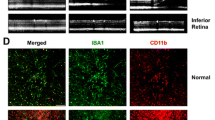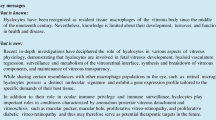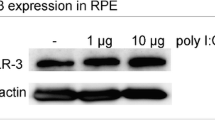Abstract
• Background: Macrophages play an important role in several ocular diseases. Because macrophages localized in ocular tissues may be derived from blood monocytes, the effect of vitreous [containing transforming growth factor-β 2 (TGF-β2) and hyaluronic acid] on blood monocytes, maturating in the tissue to macrophages, was determined. • Methods: Human monocytes were cultured with and without vitreous in RPMI 1640 medium containing human AB serum. As a parameter of activation the release of interleukin-6 was measured by the B9 bioassay; as an indication of maturation, the content of acid phosphatase and the increase in cell size were assessed. • Results: Monocytes in vitreous-containing medium grew more slowly than did control monocytes. Monocytes cultured in 10% vitreous released 51% less, and in 20% vitreous 73% less, interleukin-6 than control monocytes. Vitreous at 20% significantly (P=.0075) reduced the amount of acid phosphatase by 80% over a 4-day culture period. This reduction was partially eliminated with neutralizing antibodies to TGF-β (P=0.0014). Furthermore, human recombinant TGF-β2 increased the activity of acid phosphatase in monocytes at 1.25 ng/ml and reduced it (P<0.0001) at higher concentrations (5–10 ng/ml). Hyaluronic acid showed an effect additive to that of TGF-β in further diminishing the amount of acid phosphatase (P=0.026). • Conclusion: Vitreous exerts a regulatory effect on monocyte activation and maturation by its content of TGF-β and possibly hyaluronic acid and may, thus, modify the inflammatory or immune response in the eye.
Similar content being viewed by others
References
Akiyama Y, Griffith R, Miller P, Stevenson GW, Lund S, Kanapa DJ, Stevenson HC (1988) Effects of adherence, activation, and distinct serum proteins on the in vitro human monocyte maturation process. J Leukoc Biol 43:224–231
Balazs EA, Denlinger JL (1984) The vitreous. In: Davson H (ed) The Eye. Academic Press, Orlando, pp 533–589
Boer JH de, Limpens J, Orengo-Nania S, Jong PTVM de, Heij EL, Kijlstra A (1994) Low mature TGF-b2 levels in aqueous humor during uveitis. Invest Ophthalmol Vis Sci 35:3702–3710
Charteris DG, Hiscott P, Robey HL, Gregor ZJ, Lightman SL, Grierson I (1993) Inflammatory cells in proliferative vitreoretinopathy subretinal membranes. Ophthalmology 100:43–46
Connor TB Jr, Roberts AB, Sporn MB, Danielpour D, Dart LL, Michels RG, Bustros S de, Enger C, Kato H, Lansing M, Hayashi H, Glaser BM (1989) Correlation of fibrosis and transforming growth factor beta type 2 levels in the eye. J Clin Invest 83: 1661–1666
Derynck R (1994) Transforming growth factor beta. In: Thomson A (ed) The cytokine handbook. Harcourt Brace, London, pp 319–432
Eisenstein R, Grant-Bertacchini D (1991) Growth inhibitory activities in avascular tissues are recognized by anti-transforming growth factor beta antibodies. Curr Eye Res 10:157–162
Ennist DL, Jones KH (1983) Rapid method for identification of macrophages in suspension by acid alpha-naphthyl acetate esterase activity. J Histochem Cytochem 31:960–963
Fukuda N, Kubo A, Izumi Y, Soma M, Kanmatsuse K (1995) Characteristics and expression of transforming growth factor-beta receptor subtypes on vascular smooth muscle cells from spontaneously hypertensive rats. J Hypertens 13:831–837
Furth R van (1992) Production and migration of monocytes and kinetics of macrophages. In: Furth R van (ed) Mononuclear phagocytes: biology of monocytes and macrophages. Kluwer, Dordrecht, pp 3–12
Gloor BP (1972) Zur Frage der Beteiligung der Glaskörperrindenzellen bei experimenteller Uveitis. Mod Probl Ophthalmol 10:41–48
Hirokawa M, Gray JD, Takahashi T, Horwitz DA (1992) Human resting B lymphocytes can serve as accessory cells for anti-CD2-induced T cell activation. J Immunol 149:1859–1866
Hofman FM, Wright AD, Dohadwala MM, Wong-Staal F, Walker SM (1993) Exogenous fat protein activates human endothelial cells. Blood 82: 2774–2780
Keller JR, Bartelmez SH, Sitnicka E, Ruscetti FW, Ortiz M, Gooya JM, Jacobsen SE (1994) Distinct and overlapping direct effects of macrophage inflammatory protein-1 alpha and transforming growth factor beta on hematopoietic progenitor/stem cell growth. Blood 84:2175–2181
Kirchhof B, Sorgente N (1989) Pathogenesis of proliferative vitreoretinopathy. Modulation of retinal pigment epithelial cell functions by vitreous and macrophages. Dev Ophthalmol 16:1–53
Leibovich SL, Ross R (1975) The role of macrophage in wound repair: a study with hydrocortisone and antimacrophage serum. Am J Pathol 78:71–99
Limb GA, Little BC, Meager A, Ogilvie JA, Wolstencroft RA, Franks WA, Chignell AH, Dumonde DC (1991) Cytokines in proliferative vitreoretinopathy. Eye 5:686–693
Nakagawara A, Nathan CF, Cohn ZA (1981) Hydrogen peroxide metabolism in human monocytes during differentiation in vitro. J Clin Invest 68:1243–1252
Pepper MS, Vassalli JD, Orci L, Montesano R (1993) Biphasic effect of transforming growth factor-beta 1 on in vitro angiogenesis. Exp Cell Res 204:356–363
Ruppert J, Peters H (1991) IL-6 and IL-1 enhance the accessory activity of human blood monocytes during differentiation to macrophages. J Immunol 146:144–149
Sandberg N (1964) Time relationship between administration of cortisone and wound healing in rats. Acta Chir Scand 127:446–455
Shull MM, Ormsby I, Kier AB, Pawlowski S, Diebold RJ, Yin M, Allen R, Sidman C, Proetzel G, Calvin D, et al. (1992) Targeted disruption of the mouse transforming growth factor-beta 1 gene results in multifocal inflammatory disease. Nature 359:693–699
Streilein JW (1987) Immune regulation and the eye: a dangerous compromise. FASEB J 1:199–208
Tang S, Scheiffarth OF, Wildner G, Thurau SR, Lund OE (1992) Lymphocytes, macrophages and HLA-DR expression in vitreal and epiretinal membranes of proliferative vitreoretinopathy. An immunohistochemical study. Ger J Ophthalmol 1:176–179
Van Damme J, Van Beeumen J, Decock B, Van Snick J, De Ley M, Biliau A (1988) Separation and comparision of two monokines with lymphocyte activating factor activity (interleukin-1 beta and hybridoma growth factor): identification of leucocyte derived HGF as interleukin-6. J Immunol 140:1534–1541
Young E, Lutty GA (1987) Modulation of human lymphocyte proliferation by normal bovine vitreous. Invest Ophthalmol Vis Sci 28:753–756
Author information
Authors and Affiliations
Rights and permissions
About this article
Cite this article
Osuský, R., Walker, S.M. & Ryan, S.J. Vitreous body affects activation and maturation of monocytes into macrophages. Graefe's Arch Clin Exp Ophthalmol 234, 637–642 (1996). https://doi.org/10.1007/BF00185298
Received:
Revised:
Accepted:
Issue Date:
DOI: https://doi.org/10.1007/BF00185298




